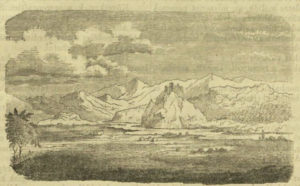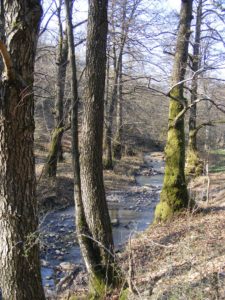Várasfenes (Fenes) Bélavár

Várasfenes (until 1899 Fenes, in Romanian Finiș) is a village in Bihar county, Romania. The castle ruin lies 3 km south-south-west of Várasfenes, on a hill rising on the right bank of the Fenes stream, on the other side of the Fekete Kőrös River. The Fenes stream flows into the Fekete Kőrös. The castle is situated among hills and can be reached by following the stream valley.

The castle of Várfenes is situated on an isolated wooded plateau, with a serpentine road leading up to it. The ruins indicate the existence of a relatively large fortress with an irregular square plan.

Tradition has it that it was built by King Béla IV before he had become a king, which is why it is also called Bélavár. In reality, it was built by Bishop Vince of Várd, as the castle belonged to the Bishopric of Várad (Nagyvárad, Oradea). It was built around 1244 to protect the bishopric’s estates here. The road to the bishop’s silver mines and to Transylvania, near the neighboring Borsa clan estates, passed through it. The castle was probably completed after the rebellion of Miklós of the Geregye clan (1277). The castle’s inhabitants were supplied with food (salt, wheat, flour) from the bishop’s neighboring villages.

In 1294-May, Borsa Lóránt (Roland of Borsa Clan), a Transylvanian Voivode, and his brothers quarreled with the Bishop and besieged and starved the castle. At the time, the castle was defended by a garrison led by Bishop Benedek’s brother Jakab, Benedek’s son László and Csatári Pál.

The name of Fenes (Várasfenes) was mentioned in a document between 1291 and 1294 in the form “castrum nostrum [ep-i] Fenes”; according to the account of the bishop of that time, he brought 504 cubic meters of grain …, 400 pieces of salt in the castle. It is thought that the castle also served as a summer residence for the bishops of Várad.

Later it was also calledi: Fenes vára (1294), and Benedictus sacerdos de v. Fenes, Fabianus sacerdos de = the castle of the Bishop of Várad, between 1332 and 1337. In 1808 it was called Bélavára, in 1808 Fenes aliis Fényes h., Fenis val., and in 1913 Várasfenes. According to the papal tithe register, his priest gave a papal tithe of 14 “garas” (silver coin) in 13 coins in 1332, 13 in 1333 and in 1334, 12 in 1335, and the same in 1336-1337.

The castellans are mentioned in 1451, but their names are not known. We can assume that the castle was the center of the large surrounding bishop’s estate, and from a military point of view, the nobility under the church were on military service there. In 1548 the name “Béla Castle” appears. At that time it was owned by Martinuzzi György, from whom King Ferdinand took it and gave it to his loyal follower, Tahy Ferenc.

During the Fifteen Years’ War, General Basta stayed in the area for a long time, and in 1602 he attacked the castle of Almás. He promised the defenders a free retreat in exchange for surrendering the castle, but the defenders were massacred by Basta’s soldiers when they left the castle.

The castle temporarily became the property of the treasury, and Csáki István managed to regain it only in 1634. In 1658, the castle suffered its last siege: the Crimean Tartars who were advancing from Kolozsvár (Klausenburg, Cluj-Napoca) towards Meszes, captured it, the inhabitants of the area who had fled were taken prisoner and the castle was burnt. It was never restored.

It was occupied by the Turks in the mid-17th century. As it had no particular strategic importance, its role in the modern era is unknown. In 1711, it was seized from the rebellious peasants by the troops of the Habsburgs and destroyed in the 18th century.

At the beginning of the 19th century, the Csáki family started to build a mansion in Nagyalmás, for which they also used the stones of the castle. As a result of all this destruction and regular demolitions, only a few triangular castle walls are still standing. The ruins indicate the existence of a relatively large castle with an irregular square plan. It was surrounded by three concentric moats, one of which was 15 m wide and 8 m deep. Some very ruined wall fragments remain inside the castle. Some of the carved stones are Gothic. Since Bunyitai Vince published the first and only plan of the castle in the 19th century, it has become even more ruined.

It consisted of at least four levels. The ground floor was probably vaulted. Above it, traces of two plank ceilings can be observed. On the first floor, there was a wide window with a seat. A gateway was located towards the center of the southern castle wall. One side was approximately 7.5 m long, with external buttresses at each corner. It was still visible in the 19th century, but its former shape can no longer be deduced from the walls that stand today.

In 1910 the village had 1949 inhabitants, mostly Hungarians, with a significant Romanian minority. Until the Treaty of Trianon, it belonged to the Belényesi district of Bihar County. In 1992, its 3,683 inhabitants, including its partner municipalities, were 1,977 Romanians, 1,579 Hungarians, 125 Gypsies, and 2 Germans.
(Sources: Wikipedia, and Erdélyi barangolások, http://erdely.utjaim.hu/varasfenes.html)

Dear Readers, I can only make this content available through small donations or by selling my books or T-shirts.
If you like my writings, please feel free to support me with a coffee here:
You can check out my books on Amazon or Draft2Digital, they are available in hardcover, paperback, or ebook:
https://www.amazon.com/dp/198020490X or at https://books2read.com/b/boYd81
 My books “33 Castles, Battles, Legends” and “The Ring of Kékkő Castle”
My books “33 Castles, Battles, Legends” and “The Ring of Kékkő Castle”
My work can also be followed and supported on Patreon: Become a Patron!http://Become a Patron!

Here are more pictures of Várfenes castle:
And do not forget to adopt a Hungarian castle:






















